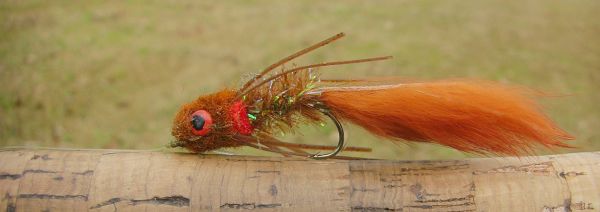
Taunt them into fighting back with Wilson’s fly
In the movie “A Christmas Story,” Scut Farkus is the neighborhood bully who torments Ralphie Parker and his friends. Until one day when something in Ralphie snaps, and he attacks his antagonist in a most ferocious manner.
It doesn’t end well for young Mr. Farkus. Scut got what he deserved. Bullying is wrong.
Except when it applies to fish.
Largemouth bass are certainly no wimps of the aquatic world. In fact, in most waters they are the top bullies. They not only terrorize but eat other fishes, crawfishes, lizards, frogs, snakes and other inhabitants.
It’s only fitting that they be taunted in return. And I know just the fly to do it with.
The Bass Bully is the creation of Terry Wilson of Bolivar, Mo. Terry and his wife Roxanne are hardcore warmwater fly anglers and outdoor writers who’ve authored several books on fly fishing for bluegill, bass and crappie.
The Wilsons are no strangers to Louisiana. They’ve appeared at several events over the years and made fishing trips, as well. In fact, I guided Terry onto his first marsh red on the fly.
Six years ago at the Federation of Fly Fishers Gulf Coast Expo in Lake Charles, Terry demonstrated several of his famous flies, including the Bully. There’s a YouTube video of him tying the fly at that event. Search for “Fly Fish Video” and “Bass Bully.”
The basic materials of this fly are zonker strip (tail), ice chenille or estaz (body), small or medium red chenille (gills), sili-legs (legs) and sculpin wool (head).
The original version was tied on a jig hook with a 1/36- or 1/50-ounce barbell eyes. The concept was to use it as a “drop fly,” where a short cast is made over deep structure and the rod tip is pumped slowly up and down.
But there are other ways of fishing certain flies, and the Bully can be tied to accommodate all methods.
In shallow water — under 6 feet — a lighter set of eyes and a standard straight-eye hook make it a great swimbait. It’s one of the better options for working spawning beds in early spring, by dragging it slowly across the bottom.
Tie this pattern on a bendback hook, and use unweighted doll eyes, and suddenly you have a surface-swimming fly that can be tossed weedless on top of heavy cover.
So what makes the Bully so effective?
For starters, it can imitate a lizard, crawfish or salamander. Things bass love to eat.
But the secret is in the tail. Most tiers use very long zonker (rabbit) strips to give action to their flies. The tail has a teasing action, such that when the fly is worked slowly it taunts a predator into a responsive, aggressive strike.
In my observations, I’ve noticed that largemouths will readily attack a zonker fly, but not hold on like they do with plastic. Therefore it’s important that they get the hook in with the tail when they eat. Too long a tail, no hook.
The tail length on the Bully is just right!
As for tackle needed to cast this bulky fly, a 7-, 8- or 9-weight rod is recommended. Any of the “bass rated” rods work great.
As for line, a bass or redfish specialty taper fly line has more weight near the tip, and can push this fly much better than a standard weight-forward line.
Last spring I was fishing a backwater area using commie tackle and a spinnerbait, with little luck. I noticed a number of crawfish chimneys along the bank. Thinking that my “luck” couldn’t get any worse, I picked up the fly rod. To “match the hatch,” I tied on a rust-colored Bully.
It’s important to keep the fly rod tip at the waterline when fishing submergent flies, even when using a floating line. Only this way was I able to feel the tug on the other end.
On the tug, I raised the rod up 45 degrees. The rod bent and the line began moving sideways. With the fast action rod, I could feel each head shake as the bucketmouth slowly came to the surface.
After releasing the fish, I made a couple more casts before yet another tug. This time it went slack before I could respond. No problem. By simply jigging the fly in place, I was able to taunt the bass into a second strike.
If you’re not into tying flies, no problem. Bass Bullies are available from many fly shops, as well as the Wilsons’ website at www.thebluegillpond.com.


